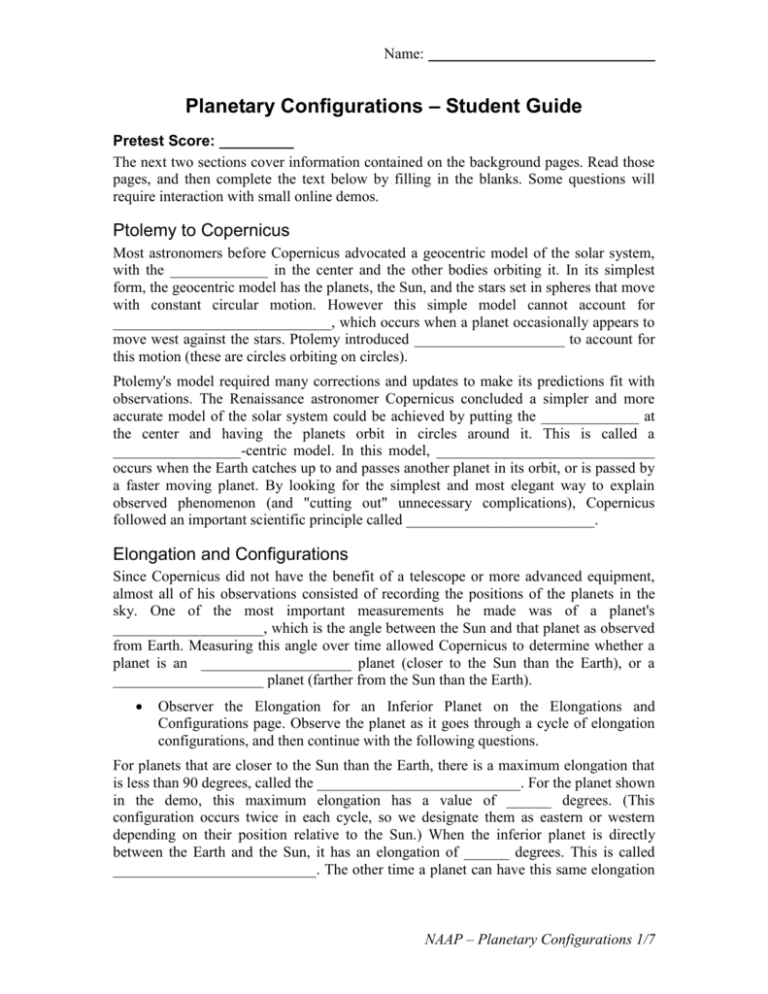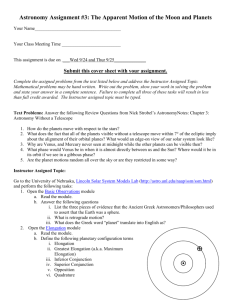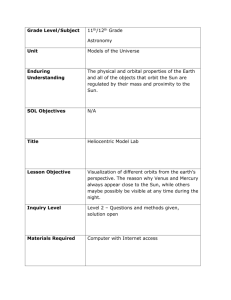naap_pcm_sg
advertisement

Name: Planetary Configurations – Student Guide Pretest Score: The next two sections cover information contained on the background pages. Read those pages, and then complete the text below by filling in the blanks. Some questions will require interaction with small online demos. Ptolemy to Copernicus Most astronomers before Copernicus advocated a geocentric model of the solar system, with the _____________ in the center and the other bodies orbiting it. In its simplest form, the geocentric model has the planets, the Sun, and the stars set in spheres that move with constant circular motion. However this simple model cannot account for _____________________________, which occurs when a planet occasionally appears to move west against the stars. Ptolemy introduced ____________________ to account for this motion (these are circles orbiting on circles). Ptolemy's model required many corrections and updates to make its predictions fit with observations. The Renaissance astronomer Copernicus concluded a simpler and more accurate model of the solar system could be achieved by putting the _____________ at the center and having the planets orbit in circles around it. This is called a _________________-centric model. In this model, _____________________________ occurs when the Earth catches up to and passes another planet in its orbit, or is passed by a faster moving planet. By looking for the simplest and most elegant way to explain observed phenomenon (and "cutting out" unnecessary complications), Copernicus followed an important scientific principle called _________________________. Elongation and Configurations Since Copernicus did not have the benefit of a telescope or more advanced equipment, almost all of his observations consisted of recording the positions of the planets in the sky. One of the most important measurements he made was of a planet's ____________________, which is the angle between the Sun and that planet as observed from Earth. Measuring this angle over time allowed Copernicus to determine whether a planet is an ____________________ planet (closer to the Sun than the Earth), or a ____________________ planet (farther from the Sun than the Earth). Observer the Elongation for an Inferior Planet on the Elongations and Configurations page. Observe the planet as it goes through a cycle of elongation configurations, and then continue with the following questions. For planets that are closer to the Sun than the Earth, there is a maximum elongation that is less than 90 degrees, called the ___________________________. For the planet shown in the demo, this maximum elongation has a value of ______ degrees. (This configuration occurs twice in each cycle, so we designate them as eastern or western depending on their position relative to the Sun.) When the inferior planet is directly between the Earth and the Sun, it has an elongation of ______ degrees. This is called ___________________________. The other time a planet can have this same elongation NAAP – Planetary Configurations 1/7 value occurs when the Sun is directly between the planet and the Earth. This configuration is called ___________________________. Observer the Elongation for a Superior Planet on the Elongations and Configurations page. Observe the planet as it goes through a cycle of elongation configurations, and then continue with the following questions. When a superior planet has an elongation of 90 degrees, we say it is at ______________________ (this configuration has both eastern and western apparitions). The largest elongation a superior planet can have is ______ degrees. When this occurs, we say the planet is at ______________________. When the elongation is 0 degrees, the planet is at ___________________________. To complete his model of the solar system, Copernicus needed to know both a planet’s distance from the Sun as well as its ____________________ period, which is the amount of time it takes a planet to orbit the Sun when viewed from a fixed frame of reference (for example, relative to the stars). Since an observer on the Earth is not in a fixed frame of reference, Copernicus first had to find a planet's ____________________ period, which is the amount of time it takes a planet to complete a cycle of elongation configurations. Planetary Configurations Simulator Open the main simulator, Planetary Configurations Simulator In this simulator all the planets known to Copernicus are shown with their orbits to scale. In order from the Sun these are: Mercury, Venus, Earth, Mars, Jupiter, and Saturn. Since the more distant planets have much more space between them, there is a zoom-slider near bottom of the simulator. Zooming all the way in allows you to see the inner solar system more clearly. The top right panel is the Planets panel. It tells the simulator which planet's elongation it should follow. Below the Planets panel is the Elongation Configuration panel. This is used to select which configuration to stop at for the chosen planet. Notice that the choice of configurations depends on whether the planet selected above is an inferior or superior planet. o Example: Suppose “Mars” is chosen in the Planets panel and “Quadrature” is chosen in the Elongation Configuration panel. Then every time Mars is at that configuration the animation will stop, and a line will be drawn showing the angle between the Sun, Earth, and Mars. The Elongation Value panel shows the elongation of the chosen planet. In the example above, when Mars is at quadrature the elongation value will read 90 degrees. (Note that the measurement may not be exactly 90 degrees, but it will be close.) The next panel is the Clock panel, which is a utility that functions like a stopwatch. Pressing the Zero Clock button will reset the time. When the animation runs, the clock will count out the elapsed time. NAAP – Planetary Configurations 2/7 The last panel is the Controls panel. When the simulator is running the button will say Stop, and pressing it will stop the animation. To start the simulator again, press Animate. The speed slider below the button allows you to control the how fast the simulator runs. Question 1: Press the Animate button in the Controls panel to watch the planets move around the Sun. What relationship do you notice between how fast a planet moves in its orbit and its distance from the Sun? Question 2: In this exercise we will measure the synodic period of Mercury. Since Mercury is the closest planet to the Sun you should zoom all the way in, if you have not already done so. Now, choose "Mercury" in the Planets panel, and then "Superior Conjunction" in the Elongation Configuration panel. Run the simulator until Mercury comes to superior conjunction, at which point the simulator will stop. Zero the clock. Press the Animate button to restart the simulator. When Mercury returns to superior conjunction again the simulator will stop. The time elapsed in the Clock panel is the time it took Mercury and the Earth to return to the same elongation configuration (superior conjunction), which by definition is the synodic period of Mercury. What is the synodic period of Mercury? Question 3: In the previous exercise superior conjunction was used as the reference configuration, but in practice it is not the best elongation configuration to use. Explain why. What is the best elongation configuration to use? (Hint, when is an inferior planet easiest to observe?) NAAP – Planetary Configurations 3/7 Question 4: Use greatest elongation as the reference configuration to calculate the synodic period of Venus. (Be careful. There are two different occurrences of greatest elongation for an inferior planet: eastern and western.) Also, record the value of the greatest elongation of Venus (when Venus stops at greatest elongation, record the angle shown in the Elongation Value panel). Synodic period of Venus: Greatest elongation of Venus: What general trend do you notice between an inferior planet's distance from the Earth and its synodic period? Question 5: Now use the simulator to find the value of Mercury's greatest elongation. Greatest elongation of Mercury: Compare the values of greatest elongation for Mercury and Venus. What relationship do you notice between the value of greatest elongation of a planet and it's distance from the Sun? Question 6: Now we will measure the synodic period of Mars. Since Mars is a superior planet we have a different set of elongation configurations to choose from. For this exercise, select “Conjunction” in the Elongation Configuration panel. As before, set Mars up in this configuration, zero the clock, and then animate the simulator again to see how long it takes Mars to return to the same configuration. Synodic period of Mars: NAAP – Planetary Configurations 4/7 Question 7: Just as with superior conjunction in Exercise 2, conjunction is not the best configuration to observe a superior planet. Explain why this is, and explain which configuration is best for observing a superior planet. Measure the synodic periods of Jupiter and Saturn using opposition as your reference configuration. (You may need to zoom out in order to see these planets.) Synodic period of Jupiter: Synodic period of Saturn: Question 8: Look over the synodic periods of the superior planets. Is there a trend? What value does the synodic period of a superior planet get closer to the farther away the planet is from the Earth? Explain this trend, using a diagram if helpful. Compare your answer above and your answer to the last part of Question 3, and then state a relationship between a planet’s synodic period and its distance from Earth that is valid for both inferior and superior planets. Question 9: So far we have only considered elongations of planets as viewed from Earth. Suppose you were standing on Mars, watching the planets go through their motions. Could you use the same terminology as before to explain the configurations of other planets? Yes, you could – the only difference would be that there is an additional inferior planet: the Earth. As an observer on Mars, you would see the Earth go through the same NAAP – Planetary Configurations 5/7 configurations as any other inferior planet. For example, when the Earth appears on the opposite side of the Sun as viewed from Mars, it is at superior conjunction. When the Earth appears at superior conjunction from Mars, at what configuration does Mars appear from Earth? Set up the simulator so that the Earth appears at superior conjunction from Mars. Zero the clock. Animate the simulator and continue until the Earth is again at superior conjunction as viewed from Mars. The amount of time that has passed is the amount of time it takes the Earth to return to the same elongation configuration – that is, the synodic period of Earth as observed from Mars. Record the synodic period of Earth as viewed from Mars: How does this answer compare with the synodic period of Mars as found in Question 6? Explain why they are related. Question 10: (Optional, requires calculator) Copernicus was interested in measuring the synodic periods of the planets so that he could calculate their sidereal periods. In this exercise we will calculate the sidereal periods of the planets using the data you have already collected. Recall that the sidereal and synodic periods of a planet are related by 1 1 1 , for inferior planets S P E 1 1 1 , for superior planets S E P where P stands for the planet's sidereal period, S stands for the planet's synodic period, and E stands for the Earth's sidereal period. NAAP – Planetary Configurations 6/7 We will now work an example to see how these formulas are used to find a planet’s sidereal period. The synodic period of Jupiter is 1.09 yr. Since E is 1 year, we have 1 1 1 1 1 , so 0.0826 , therefore P 12 yr. 1.09 yr 1yr P P yr Now calculate the sidereal periods of the rest of the planets to complete the table below. (Be sure to use the same units of time for each of the variables. If you measured S in days then you should convert it to years by dividing by 365.25 days/year.) Planet Synodic Period (from exercises above) Sidereal Period (calculated) – 1 yr 1.09 yr 12 yr Mercury Venus Earth Mars Jupiter Saturn Is there a relationship between the sidereal period of a planet and its distance from the Sun? How does this relate to your observations in Question 1? Posttest Score: NAAP – Planetary Configurations 7/7









